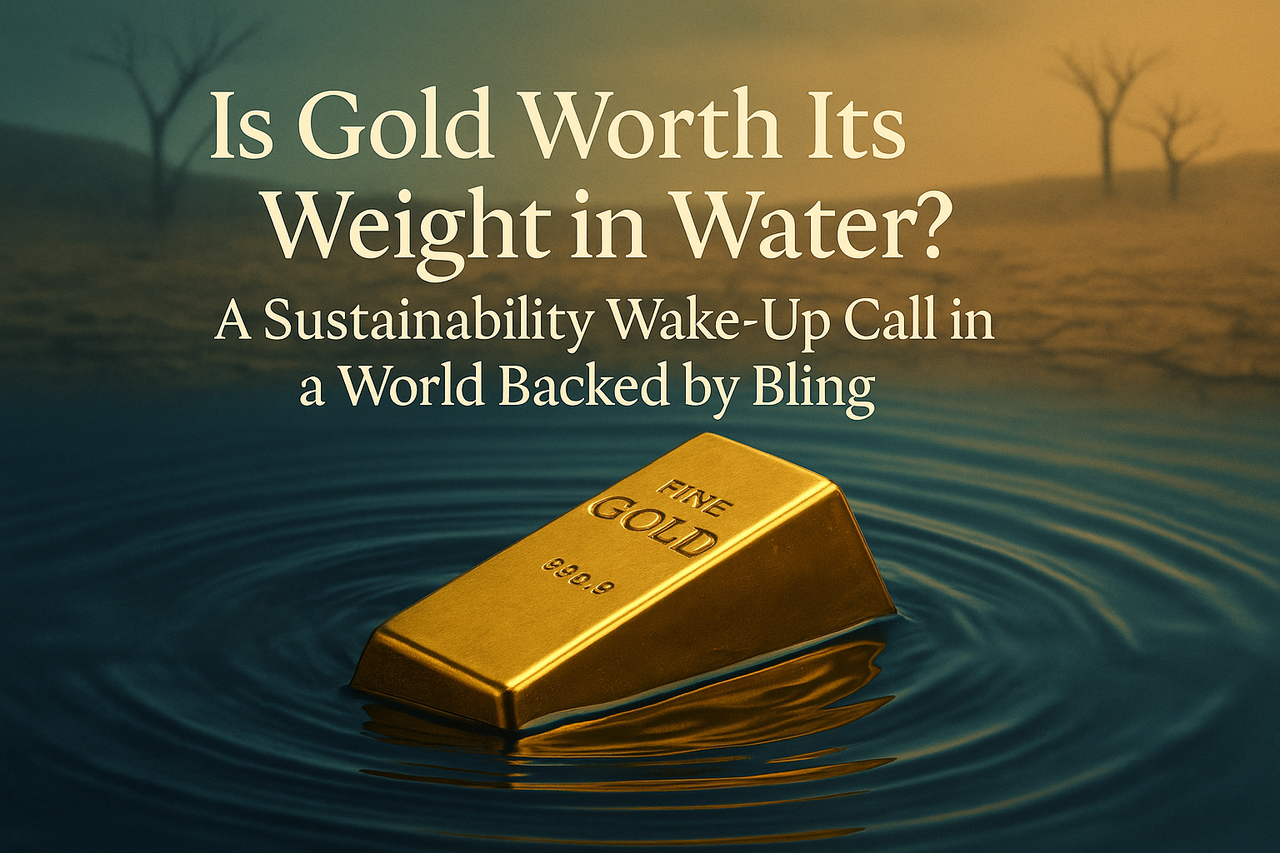My wife has been persistently lobbying me to invest in gold jewelry. From anniversaries to birthdays to the occasional “just because” moment, she believes gold never goes out of style or decreases in value. And honestly, she’s right about the style part, and arguably about the value. Gold has been a symbol of wealth, power, and beauty for millennia, adored by pharaohs, emperors, and modern-day fashionistas alike. But as someone who tries to live consciously, especially when it comes to environmental sustainability, I had to ask myself, what’s the real cost of that glittering bangle?
So I started digging, and what I found shocked me. According to various claims, it takes up to 400,000 liters of water to produce just 1 kilogram of gold. That’s the equivalent of one year's worth of drinking water for 1,000 people. And that’s just the water footprint, don’t get me started on the toxic byproducts, deforestation, or the staggering energy consumption involved in gold mining. It made me wonder, is our cultural and financial obsession with gold really worth its ecological price?
There is no smoke without fire. Let's assume the claim, which I was not able to find any concrete peer-reviewed research to support, is false, and only half of that amount of water is required to mine a kilogram of gold, it is still a cause for concern.
The Hidden Thirst of Gold Mining
Gold mining is among the most environmentally intensive industries on Earth. To yield just a kilogram of gold, miners process tons of ore, requiring enormous quantities of water to separate gold from rock, suppress dust, and manage toxic chemicals like cyanide and mercury. The result? Freshwater depletion, poisoned rivers, and long-term ecosystem disruption.
Even worse, much of this mining occurs in regions already facing water scarcity. Places where clean drinking water is a luxury. In countries like Peru, Ghana, and South Africa, where gold extraction is a major industry, local communities often deal with the consequences, including degraded farmland, displaced wildlife, and contaminated water supplies. While affluent markets enjoy the sparkle, those living near mines pay the price. This isn't just an environmental issue, it's a global justice issue.
But It’s More Than Jewelry: Gold Backs Wealth
Here’s where it gets deeper. Gold isn’t just adorning necks and wrists, it’s still deeply embedded in the financial systems of many nations. While most modern currencies are no longer on the traditional gold standard, central banks around the world still hold thousands of tons of gold as a hedge against inflation and financial crises.
Countries like the U.S., Germany, Russia, and China hold vast gold reserves in their central banks. This enduring trust in gold as a safe haven asset means demand continues not just from consumers, but from governments as well. In fact, as of 2024, central banks collectively own over 35,000 metric tons of gold, making the yellow metal both a cultural symbol and a strategic reserve.
This widespread financial dependency reinforces mining, perpetuating its environmental toll. While digital assets and fiat currency dominate day-to-day transactions, the emotional and economic anchor of gold continues to influence global markets. That means each new ounce of gold doesn’t just glisten, it echoes with the splash of thousands of liters of water lost.
The Human Cost: Labor Exploitation and Conflict Gold
Beyond the environmental devastation, gold mining is often linked to human rights abuses. In many developing nations, artisanal and small-scale miners, including children, work in dangerous conditions for meager wages. Worse, in conflict zones like the Democratic Republic of Congo, blood gold fuels armed groups, perpetuating violence and instability. The same can be said for some conflicts in my country, Nigeria. Gold mining has been reported to be the source of conflicts and banditry in states like Zamfara and Osun.
Even in large-scale industrial mining, worker safety and fair wages are frequently overlooked. The 2015 Gold King Mine spill in the U.S. released 3 million gallons of toxic wastewater into the Animas River, highlighting how even regulated mining can have catastrophic failures.
What Can We Do Instead? Recycled Gold and Ethical Sourcing
So what’s the alternative? Giving up on gold entirely might be unrealistic, after all, it’s deeply woven into our traditions and economies. But choosing recycled gold or supporting ethical mining initiatives could offer a path forward.
Recycled gold, sourced from electronics, old jewelry, or industrial byproducts, requires significantly less water and energy to process. Certifications like Fairmined and the Responsible Jewellery Council ensure higher environmental and labor standards. Lab-grown gold, though still in early stages, could one day provide a sustainable alternative.
Personally, I’ve begun looking into options that align better with my values, whether that means selecting from recycled collections or opting for non-traditional gifts that are equally meaningful. My wife and I are exploring sustainable jewelry together now, and the experience has added an unexpected richness to the idea of giving.
A Choice for the Future
At the heart of it, this is a question of values. Gold may continue to serve as a financial backstop, but our purchasing choices influence demand, which, in turn, shapes how this resource is extracted and respected. The true measure of something precious isn’t just its market value or aesthetic appeal, but the real cost behind its creation.
TD:DR: Is Gold Worth It?
Gold’s allure is undeniable, but its environmental and human cost forces us to reconsider its true worth. As consumers, investors, and global citizens, we have the power to shift demand toward more responsible practices. Maybe the real luxury isn’t in owning gold, but in ensuring that its brilliance doesn’t come at the expense of our planet and its people.
So next time my wife suggests a gold necklace, I might just propose something different, like a shared investment in a sustainable future. Because in the end, the most precious things in life aren’t the ones we wear, but the world we leave behind.
